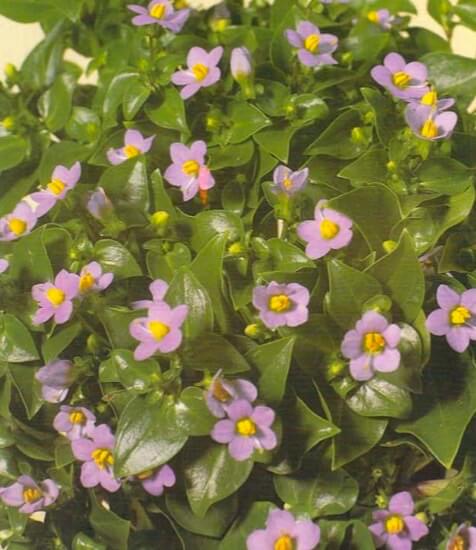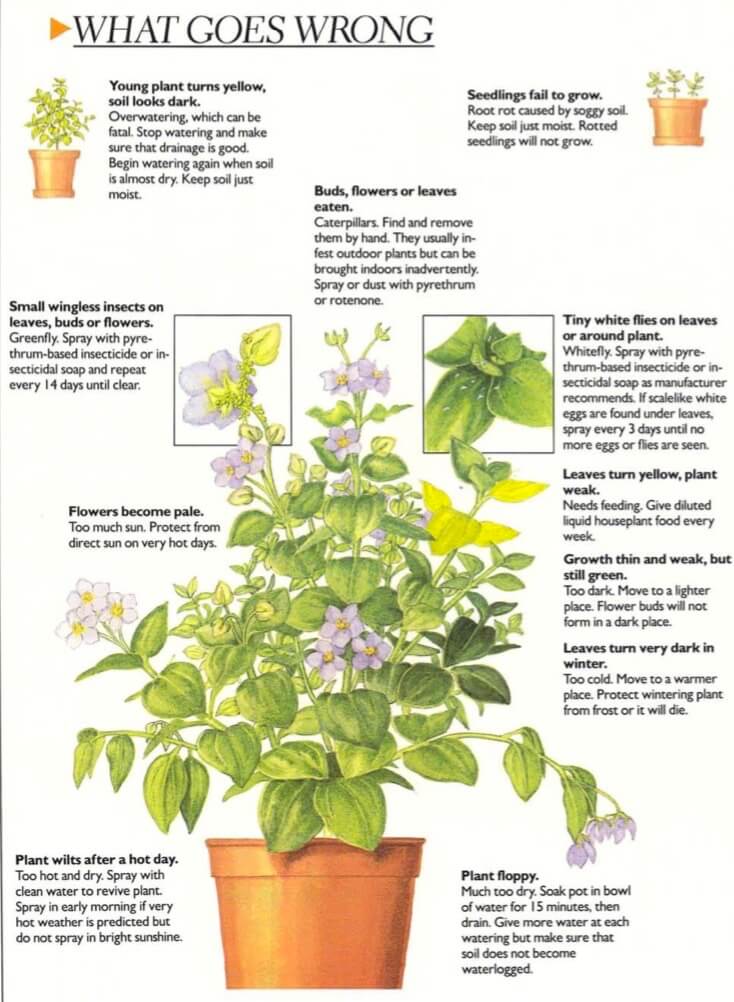[Ebook Việt Hoá] The Instant Guide to Healthy Houseplants (Hướng dẫn tức thời để chăm cây trong nhà khoẻ mạnh), Chi Exacum
[Ebook Việt Hoá] The Instant Guide to Healthy Houseplants: Exacum affine (Persian violet, German violet)
- Nguồn: [Ebook Việt Hoá] The Instant Guide to Healthy Houseplants (Hướng dẫn tức thời để chăm cây trong nhà khoẻ mạnh)
- Biên tập: Dũng Cá Xinh
- Biên dịch: Team Codai.net
English
The Persian violet, a native of the tropics, is a small, bushy biennial that is often treated as an annual. It needs a light, fairly warm and moist environment to thrive. Plants can be bought in bud in early summer, or they can be raised from seed. Sow seed in a tray of seed potting soil in early spring. Germination takes about 3 weeks. The first tiny flowers should appear in midsummer, and the plant should continue flowering into autumn.

Light
Needs full light at all times, but protect flowers from direct, midday sun on hot days.
Temperature
Germination, 60°F (16°C), then keep at same temperature for best flowers. Winter, not below 40°F (4°C), not above 60°F (16°C).
Water
Keep seedlings moist, gradually increasing water as plant begins to flower. Soil should always be moist while growing, so water 2-3 times a week in summer. In winter, allow to dry out thoroughly between waterings, giving a limited amount every 10-14 days.
Soil
Use soilless potting mix.
Humidity
In hot weather, spray lightly in the morning or evening. Do not spray in winter.
Feeding
Feed weekly with liquid house- plant food diluted t o manufacturer’s recommended strength; begin 4 weeks after plants are in final pots.
After flowering
Plant can be maintained to flower again the following summer. Allow growth to die back when flowering is finished in autumn. Cease feeding and reduce watering to keep soil barely moist. Keep in a cool place protected from frost, such as an enclosed porch. In early spring, transfer to a 4 1/ 2 inches (11 cm) pot and bring into a warm, light location again.
Propagation
- 1. Seed is very fine. Mix it with fine sand for even sowing. Barely cover with dry soil.
- 2. Place t ray in plastic bag, cover with paper and give full light as soon as seedlings show.

What Goes Wrong

- Young plant turns yellow, soil looks dark: Overwatering. which can be fatal. Stop watering and make sure that drainage is good. Begin watering again when soil is almost dry. Keep soil just moist.
- Seedlings fail to grow: Root rot caused by soggy soil. Keep soil just moist. Rotted seedlings will not grow.
- Small wingless insects on leaves, buds or flowers: Greenfly. Spray with pyrethrum-based insecticide or insecticidal soap and repeat every 14 days until clear.
- Flowers become pale: Too much sun. Protect from direct sun on very hot days.
- Buds, flowers or leaves eaten: Caterpillars. Find and remove them by hand. They usually infest outdoor plants but can be brought indoors inadvertently. Spray or dust with pyrethrum or rotenone.
- Plant wilts after a hot day: Too hot and dry. Spray with clean water to revive plant. Spray in early morning if very hot weather is predicted but do not spray in bright sunshine.
- Plant floppy: Much too dry. Soak pot in bowl of water for 15 minutes, then drain. Give more water at each watering but make sure that soil does not become waterlogged.
- Tiny white flies on leaves or around plant: Whitefly. Spray with pyrethrum-based insecticide or insecticidal soap as manufacturer recommends. If scalelike white eggs are found under leaves, spray every 3 days until no more eggs or flies are seen.
- Leaves turn yellow, plant weak: Needs feeding. Give diluted liquid houseplant food every week.
- Growth thin and weak, but still green: Too dark. Move to a lighter place. Flower buds will not form in a dark place.
- Leaves turn very dark in winter: Too cold. Move to a warmer place. Protect wintering plant from frost or it will die.
Tiếng Việt
Hoa violet Ba Tư, một loài bản địa của vùng nhiệt đới, là một loài nhỏ, rậm rạp hai năm một lần thường được coi là cây thường niên. Nó cần một môi trường ánh sáng, khá ấm và ẩm để phát triển mạnh. Cây có thể được mua từ chồi vào đầu mùa hè hoặc chúng có thể được nuôi từ hạt. Gieo hạt vào khay bầu đất vào đầu mùa xuân. Quá trình nảy mầm mất khoảng 3 tuần. Những bông hoa nhỏ đầu tiên sẽ xuất hiện vào giữa mùa hè và cây sẽ tiếp tục ra hoa vào mùa thu.

Ánh sáng
Cần ánh sáng đầy đủ mọi lúc, nhưng phải bảo vệ hoa khỏi ánh nắng trực tiếp giữa trưa vào những ngày nắng nóng.
Nhiệt độ
Nảy mầm, 60 ° F (16 ° C), sau đó giữ ở nhiệt độ tương tự để có hoa tốt nhất. Mùa đông, không dưới 40 ° F (4 ° C), không trên 60 ° F (16 ° C).
Nước
Giữ ẩm cho cây con, tăng dần lượng nước khi cây bắt đầu ra hoa. Đất phải luôn ẩm trong khi trồng, nên tưới 2-3 lần / tuần vào mùa hè. Vào mùa đông, để khô ráo hoàn toàn giữa các lần tưới nước, hạn chế khoảng 10 – 14 ngày một lần.
Đất
Sử dụng hỗn hợp bầu không đất.
Độ ẩm
Khi trời nắng nóng, phun nhẹ vào buổi sáng hoặc chiều tối. Không phun vào mùa đông.
Bón phân
Bón phân hàng tuần với phân bón cây trồng dạng lỏng được pha loãng theo nồng độ khuyến nghị của nhà sản xuất; bắt đầu 4 tuần sau khi cây ở trong chậu cuối cùng.
Sau khi ra hoa
Cây có thể được duy trì để ra hoa trở lại vào mùa hè năm sau. Cho phép rễ cây tiếp tục sinh trưởng khi mùa ra hoa kết thúc vào mùa thu. Ngừng bón phân và giảm tưới nước để giữ cho đất vừa đủ ẩm. Giữ ở một nơi mát mẻ được bảo vệ khỏi sương giá, chẳng hạn như một mái hiên kín. Vào đầu mùa xuân, chuyển sang chậu 1/2 inch (11 cm) và đưa vào vị trí ấm áp và có ánh sáng trở lại.
Nhân giống
- 1. Hạt giống tốt. Trộn với cát mịn để gieo đều. Chỉ phủ một lớp đất khô.
- 2. Đặt khay vào túi ni lông, phủ giấy và di chuyển đến nơi có ánh sáng đầy đủ ngay khi cây con xuất hiện.

Những vấn đề có thể xảy ra

- Cây non chuyển sang màu vàng, đất trông sẫm màu: Tưới quá nhiều có thể gây chết cây. Ngừng tưới nước và đảm bảo thoát nước tốt. Bắt đầu tưới lại khi đất gần như khô. Giữ đất ẩm vừa đủ.
- Cây con không phát triển được: Bệnh thối rễ do đất bị sũng nước. Giữ đất vừa ẩm. Cây con bị thối rữa sẽ không phát triển.
- Côn trùng không cánh nhỏ trên lá, chồi hoặc hoa: Ruồi xanh. Phun thuốc diệt côn trùng hoặc xà phòng diệt côn trùng pyrethrum và lặp lại sau mỗi 14 ngày cho đến khi khỏi bệnh.
- Hoa trở nên nhợt nhạt: Quá nhiều nắng. Bảo vệ khỏi ánh nắng trực tiếp vào những ngày quá nóng.
- Búp, hoa hoặc lá bị ăn: Sâu tơ. Tìm và loại bỏ chúng bằng tay. Chúng thường phá hoại cây trồng ngoài trời nhưng có thể vô tình mang vào trong nhà. Xịt hoặc phủi bằng pyrethrum hoặc rotenone.
- Cây héo sau một ngày nắng nóng: Quá nóng và khô. Phun bằng nước sạch để cây hồi sinh. Phun vào sáng sớm nếu dự báo thời tiết rất nóng nhưng không phun vào lúc nắng chói.
- Cây mềm: Quá khô. Ngâm chậu trong bát nước khoảng 15 phút, sau đó để ráo. Thêm nước vào mỗi lần tưới nhưng đảm bảo đất không bị úng.
- Ruồi trắng li ti trên lá hoặc xung quanh cây: Bọ phấn thuốc lá. Phun thuốc trừ sâu hoặc xà phòng diệt côn trùng pyrethrum theo khuyến cáo của nhà sản xuất. Nếu phát hiện thấy trứng trắng có vảy dưới lá, phun 3 ngày một lần cho đến khi không thấy trứng hoặc ruồi nữa.
- Lá chuyển vàng, cây yếu ớt: Cần bón phân. Sử dụng phân bón hữu cơ dạng lỏng pha loãng mỗi tuần.
- Sinh trưởng mỏng và yếu, nhưng vẫn xanh: Quá tối. Di chuyển đến một nơi sáng hơn. Nụ hoa sẽ không hình thành ở nơi tối tăm.
- Mùa đông lá chuyển sang màu sẫm: Quá lạnh. Di chuyển đến một nơi ấm áp hơn. Bảo vệ cây khỏi sương giá nếu không nó sẽ chết.



